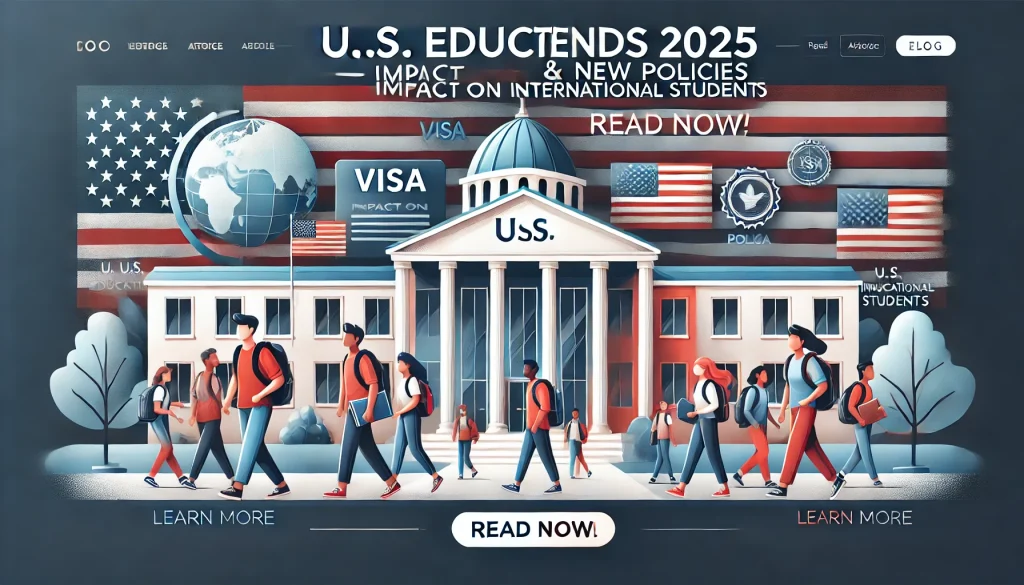Latest Trends in U.S. Education for International Students & Impact of New Trump Policies

The U.S. remains one of the most sought-after destinations for international students, offering world-class education, research opportunities, and cultural diversity. However, as of 2025, the landscape is shifting due to emerging educational trends and new policy changes under the Trump administration. This blog post explores these trends and their potential impact on international students, backed by recent reports and expert insights.
Current Trends in U.S. Education for International Students
1. Resurgence in International Student Enrollment
According to the latest Open Doors Report 2024 by the Institute of International Education (IIE), international student enrollment in the U.S. is on the rise. The number of students in graduate programs has exceeded 500,000, making up nearly 17% of all graduate students in the country (IIE Report, 2024). This signals a recovery from the pandemic-era decline and renewed global interest in U.S. education.
2. The Economic Contribution of International Students
A report by NAFSA: Association of International Educators highlights that international students contributed $39 billion to the U.S. economy in the 2022–23 academic year, marking a 10% increase from the previous year. Additionally, they supported over 368,000 jobs across various sectors (NAFSA Report, 2024).
3. AI-Powered Learning & Digital Transformation
U.S. universities are increasingly integrating AI-powered tools, such as adaptive learning platforms and virtual tutors, to personalize education for students. For example, institutions like MIT and Stanford have introduced AI-driven coursework to help students tailor their learning experiences (EdTech Magazine, 2024).
4. Rise of STEM & Business Programs
The demand for STEM (Science, Technology, Engineering, and Mathematics) and Business programs remains high among international students. According to the National Science Foundation (NSF), 60% of all international students in the U.S. are enrolled in STEM fields, primarily due to better job prospects and extended OPT (Optional Practical Training) benefits for STEM graduates (NSF, 2024).
5. Shift to Personalized Recruitment & Localized Marketing
To attract international students, U.S. institutions are using personalized marketing and localized recruitment strategies. Universities now collaborate with education agents in key markets such as India, China, and Brazil, leveraging digital campaigns tailored to each region (ICEF Monitor, 2024).
Impact of Trump’s New Policies on International Students
With Donald Trump back in office, policy shifts are expected to impact student visas, work permits, and overall ease of studying in the U.S. Below are some key areas of concern:
1. Stricter Visa Vetting & Processing Delays
One of the first executive orders signed by the new administration introduces “extreme vetting” for student visas. This could lead to longer processing times, additional documentation requirements, and increased scrutiny for students from certain countries (The PIE News, 2025).
2. Proposed Fixed-Term F-1 Visas
The administration is considering changes to the F-1 student visa structure, replacing the current “duration of status” model with fixed two- or four-year visas. If implemented, this could require students to apply for extensions mid-study, leading to uncertainty for those in longer programs (ACE, 2025).
3. Possible Reinstatement of Travel Bans
Discussions are ongoing regarding the potential reinstatement of travel bans on certain countries. If enforced, international students from these nations may face difficulties in obtaining U.S. visas or may even be denied entry (Monitor ICEF, 2025).
4. Changes to the OPT and H-1B Visa Program
- There are growing concerns that Optional Practical Training (OPT) programs—which allow international graduates to work in the U.S. for up to three years (for STEM fields)—may face restrictions.
- The administration is also reviewing H-1B visa policies, potentially making it more challenging for international students to transition to full-time employment in the U.S. after graduation (Forbes, 2025).
5. Tuition Fees and Financial Aid Restrictions
While tuition rates are already high, some universities are bracing for policy changes that may impact financial aid availability for international students. Certain federally funded scholarships and grants might see new restrictions under Trump’s proposed education funding reforms (Times Higher Education, 2025).
Conclusion: What Should International Students Do?
Despite these challenges, the U.S. remains an attractive destination for international students. To navigate these changes effectively, students should:
- Stay updated on visa policy changes via official government websites.
- Explore alternative funding options, such as university-specific scholarships and assistantships.
- Seek legal guidance if visa or work authorization policies change.
- Consider hybrid education models, including starting online and transitioning to in-person studies once policies become clearer.
With strategic planning and awareness, international students can still pursue their dreams of studying in the U.S., leveraging emerging educational trends while adapting to new policies.




